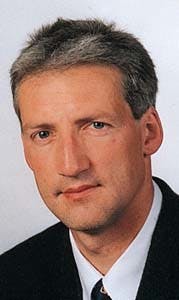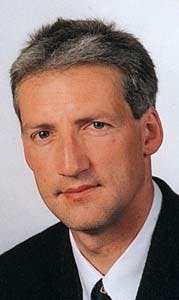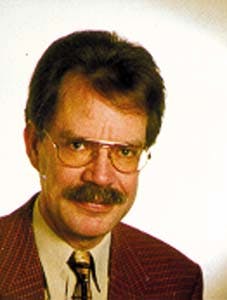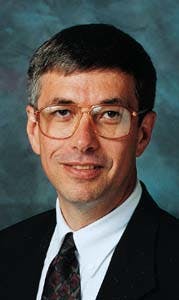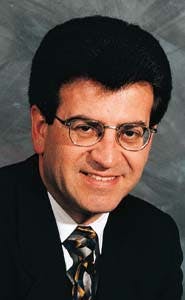Hans Besl, Wilfried KossmanA real-time, closed-loop optimization of the Penex process for light-naphtha isomerization was implemented at Bayernoil's (formerly Raffineriegesellschaft Vohburg/Ingolstadt GmbH) Ingolstadt, Germany, refinery in July 1996. Bayernoil is a joint venture of British Petroleum Co. plc, Mobil Oi Corp., Ruhr Öl GmbH, and Agip Petroli SpA.
Bayernoil Raffineriegesellschaft mbh
Ingolstadt, GermanyThomas J. Crowe, Mike Caracotsios
UOP
Des Plaines, Ill.
This UOP project demonstrates the concept of using steady-state models to optimize a nonsteady-state unit. This approach adds value to processes characterized by large time constants relative to the frequency of disturbances.
This article is an excerpt from a paper that describes techniques to optimize a multiunit naphtha complex on-line using steady state models. The naphtha complex includes naphtha hydrotreating, naphtha splitting, isomerization, and reforming in a typical refinery. These units rarely achieve steady state simultaneously. The nonsteady-state optimization of one unit can be extended to optimize a nonsteady, multiunit plant with steady-state models. In this case, although optimizing the total naphtha complex seemed more profitable, Bayernoil limited the optimization to the single Penex unit.
The nonsteady-state optimization approach accounts for about one-quarter of the total project benefit at the Bayernoil refinery.
The Penex process
Bayernoil operates its two refineries at Ingolstadt and Vohburg, Germany, as a single complex. The Penex unit, which is at the Ingolstadt refinery, produces a gasoline-blending component with a high motor octane number (MON).The Penex unit processes light straight-run naphtha from the crude unit and from purchased naphtha. The process converts low-octane, straight-chain C5-C6 paraffins to higher-octane, branched-chain isomers (Fig. 1 [78,783 bytes]). The isomerate from the Penex process is desirable because of its relatively high MON.
Typically, feed octane is on the order of 68 MON. Stabilized reactor effluent is approximately 80 MON. The lower-octane C6 isomers boil at slightly higher temperatures than the higher-octane C6 isomers. Consequently, fractionation of stabilizer bottoms in a deisohexanizer (DIH) column produces a stream of low-octane C6 isomers, which can be further upgraded by recycling them to the reactors.
At 87 MON, the overhead liquid from the DIH is the most-valuable product from this process. The DIH also has a bottoms purge stream that is used to prevent the buildup of relatively heavier C6 naphthenes and C7 components.
The Penex unit is subject to disturbances resulting from nearly daily changes in feed composition. The process has a large liquid recycle, which creates decision variables that influence the trade-off between the quality of products and the throughput capacity. The process is also nonlinear and not adequately modeled by linear or parametric models.
Optimization model
Bayernoil decided to optimize the Penex unit using a process optimization objective function which focused on process improvements. This function eliminates the need for Bayernoil's planning department to generate transfer prices for internal refinery streams.The heart of the optimization application for the Penex process is a rigorous two-phase, kinetic model. This proprietary model was developed by UOP's research and development department. The reactor model has previously been used in three real-time optimization projects.
For Bayernoil, UOP tailored the model for use with equation-based solvers. The process flowsheet was built using commercially available open-form, equation-based flowsheet optimization software to formulate the problem and to model nonproprietary operations in the process. UOP and Bayernoil identified the objective function and key process limitations.
The optimization of the Penex process involves the selection of appropriate reactor temperature targets that are dependent on feed composition and current catalyst activity. Also, degrees of freedom in the deisohexanizer (DIH) column determine the distribution between the net products and the recycle stream.
Because Bayernoil can independently control feed to the Penex unit, the fresh-feed rate to the unit becomes another degree of freedom for the optimizer. The DIH sidedraw is split between net side draw and recycle liquid to the reactors. The optimizer is used to determine how much sidedraw should be taken as a net product. In the final project implementation, six degrees of freedom in this optimization represent the operating targets from the optimizer to the process.
Optimization objectives for the Penex process are related to the operating objectives for the refinery. The Penex process produces a high-octane, gasoline-blending component, and the refinery gasoline pool is generally MON limited. The primary trade-offs among product quality, conversion, and throughput exist entirely within the battery limits of the Penex unit. Thus, octane-barrels can be maximized subject to minimum target octane.
Also, profit across the Penex unit can be optimized if consistent feed and product values are available. The constraints in the Penex process encompass the minimum octane targets and the unit equipment limits, including the quantity of combined feed to the process, the availability of makeup hydrogen, and the plant hydraulic limits that may affect how much material can be recycled.
Traditional optimization
During the course of the project, one tenet of traditional optimization practice was expanded to allow process optimization when the unit was not at steady state. The use of nonsteady-state plant optimization with a steady-state model improved the execution frequency and the overall optimizer performance.The traditional on-line optimization cycle, shown in Fig. 2 [45,335 bytes], has four fundamental steps:
- Wait for steady state. The on-line optimizer is traditionally run after the process unit has reached steady state. Steady-state detection is accomplished by continuously monitoring selected key process variables. Plant data are collected and averaged continuously. Gross errors resulting from instrument malfunctions are eliminated, and the remaining acceptable data are passed through statistical or heuristic tests to determine if the plant operation is at steady state.
- Reconcile differences. The second step in the optimization cycle handles differences between the plant measurements and the model predictions. Two basic problems are addressed during this step: parameter estimation and statistical data reconciliation.
Reconciliation involves minimizing offsets between the model and the process after gross-error detection has been accomplished. Parameter estimating, or model tuning, is frequently accomplished simultaneously with the data-reconciliation step. At the end of the reconciliation step, model-to-plant differences are identified, and the optimizer has a good representation of the actual starting condition of the plant.
- Optimize the process. The optimization step uses the reconciled model to locate the optimal set of operating conditions within the feasible operating window. The feasible operating window is defined by process and equipment constraints, certain operating targets, and any rate-of-change limits that are imposed during each execution. The validity of the optimization is based to a large extent on the valid identification of the differences between the model and the plant and the predictive ability of the process model.
- Implement the targets. The final step is implementing the targets, or setpoints, developed in the optimization step. Typical issues that need to be considered are maintaining process stability by matching output moves to process dynamics, ramping process outputs to maintain stability, and checking the available degrees of freedom at the completion of the optimization step.
Dynamic characteristics
The traditional optimization cycle requires that the plant approach steady state before beginning the generation of optimal targets through data reconciliation, optimization, and target implementation. Better reconciliation can generally be achieved from data acquired at plant operations that are closer to steady state. The quality of the optimization results is related to the quality of the reconciliation results.Because frequent optimizer execution is often desired, however, steady-state tolerances tend to be relaxed. The Penex process provides a good example of the trade-off that exists between the quality of optimization results and the frequency of optimizer execution.
The dynamic behavior of the Penex process is dominated by the DIH column. The DIH column has 100 trays with relatively high reflux-to-feed ratio. Highly refluxed columns with a large number of trays tend to achieve steady state slowly. By itself, this column would take up to 3 hr to reach steady state from a step disturbance.
However, for the entire process, the DIH sidedraw is recycled to the reactor section, which responds quickly to changes in the recycle or fresh feed. A feedback of disturbances occurs from the DIH column through the reactor section and back to the DIH column. As a result, the overall plant takes longer than 3 hr to achieve steady state.
The Bayernoil Penex unit experiences frequent feed changes because of upstream operating changes. These changes can occur as often as two times a day. Following the steady-state optimization technique outlined in Fig. 2, UOP estimated an optimization cycle schedule of about 8-10 hr to allow the process unit to achieve steady state after feed changes and after any modifications received from the optimizer.
When the frequency of process disturbances approaches the frequency of optimizer execution, the optimizer will not be able to sustain near-optimal performance in the plant. Consequently, the frequency of optimizer execution needs to be increased to achieve near-optimal performance.
New optimization technique
Because little can be done to change the dynamic characteristics of the unit, the optimization system needs to take advantage of the predictive capability of the process model. An optimization model of a typical refinery process unit has the following types of variables:- Fixed variables, such as parameters and process measurements from the plant
- Independent variables, which represent degrees of freedom in the optimization problem
- Dependent variables, such as objective function elements and model variables for which equipment constraints have been identified in the process.
UOP proposed that a sufficient condition for plant optimization may include only reconciled-data offsets and fixed-input values that are representative of the new operating condition rather than a steady state that corresponds to the same fixed-input values. The solution to a well-defined optimization problem is a function of the fixed inputs to the process model and does not depend on the path that the process takes to achieve steady state. Consequently, the traditional optimization cycle can be modified (Fig. 3 [47,974 bytes]).
The "wait for steady-state" step from the traditional cycle has been replaced with two steps: a wait step, the duration of which is determined by the desired frequency of optimizer execution, and a test step to see whether steady state has been achieved. If the plant is steady, then reconciliation is selected as the next step. If the plant is not steady, then optimization is executed using the last reconciliation results. The optimizer run can also be made conditional based on the steady-state status of fixed inputs to the model.
The incremental benefits of nonsteady-state optimization can be illustrated by showing process responses to a hypothetical disturbance. In Fig. 4,[65,180 bytes] the system waits for steady state before optimization. After a disturbance, the optimal profit value is the result of the new process conditions. The new current objective is then suboptimal because the process conditions have changed and the optimizer has yet to provide new optimal targets to the control layer.
The plant also enters a period of nonsteady-state operation as a direct result of the disturbance.
In contrast, Fig. 5 [64,701 bytes] shows optimization at the regularly scheduled time intervals even though steady state has not been achieved. A profit-value curve can be drawn based on nonsteady-state optimization.
The optimizer starts at its normally scheduled time or based on operator demand. The actual profit value again begins to move toward the theoretical as in the case of the steady-state optimization shown in Fig. 4. However, in this case, the process moves toward the optimal conditions earlier because the optimizer is not waiting for steady state to optimize.
When Figs. 4 and 5 are superimposed (Fig. 6 [47,149 bytes]), the value of the nonsteady-state optimization cycle becomes apparent. The difference between the two actual profit curves represents the incremental benefits that can be gained from running the optimizer before reaching a steady-state condition in the process.
Commercial results
The implementation of the optimizer was completed on schedule, and the application has been on-line since July 1996. Unit operation has improved considerably as a direct result of the optimizer project implementation.The key operating parameter that became apparent after an analysis of the optimization results was the yield of high-octane isomerate per unit of fresh feed. The base condition for performance without optimization was established over a 2-month period with advanced process controls in operation.
The unit was operated to draw some of the DIH sidedraw as net product. Under ideal conditions, this material would normally be recycled; however, the unit was hydraulically limited so that additional recycle would have meant lower fresh-feed rates. The operating objectives for the process were to maximize fresh feed as well as octane-barrels produced from the unit. At base conditions, the unit produced about 0.57 tons of DIH overhead material per ton of fresh feed.
After the optimizer was commissioned, the unit performance was measured for several weeks to generate comparison data. Under similar feed conditions and fresh-feed flow rate to the unit, the optimized performance yielded about 0.65 tons of DIH overhead material per ton of fresh feed. Based on economics that were current at the time the data were taken, this change in yield translated to greater than $1.5 million/year.
Under the new nonsteady-state plant-optimization paradigm, the optimizer runs every 4-6 hr, and the plant is reconciled every second or third optimization cycle on average. The more-frequent optimizer execution resulted in greater benefit to the refiner. Approximately 25% or more of the calculated benefit is estimated as attributable to the new technique.
The resulting optimizer service factor of more than 95% has been outstanding. The optimizer is virtually always available. The only circumstances that cause the optimizer to be unavailable are analyzer malfunctions or operating problems. The recovery from these circumstances is automatic and requires no manual intervention to restart the optimizer.
The maintenance requirements for the optimizer are lower than originally expected. In the operating history of the optimizer to date, maintenance has included one model tuning for a catalyst change, the addition of two new instruments to the data-reconciliation configuration, and one minor modification to the flowsheet.
The continued success of the optimizer application has been accomplished in two phases through the cooperative efforts of the participants. The first phase involved implementation of the optimizer application as a project. The second phase involves the continuing cooperation of several groups within the refinery to sustain the continued closed-loop operation of the optimizer.
Bayernoil has sustained the success of the optimizer application by continuing the team approach. The optimizer operation, which is coordinated through several departments within the refinery, creates the unit targets that were once provided by the planning department. Today the planning department provides the business perspective and continues to reevaluate the unit operating objectives.
The technology department is responsible for evaluating and maintaining the optimization models to provide technical insight into the operation of the refinery process units. The operations department is responsible for identifying physical constraints as well as identifying and overcoming operating limits that occur outside the optimization scope. The advanced control group is responsible for data communication integrity and keeping the system operational. All these tasks are required to operate the optimizer in a real-world environment.
The Authors
Hans Besl is a staff engineer working in the process performance control department of Bayernoil Raffineriegesellschaft GmbH. Previously, was a shift supervisor in the operations department and a control engineer responsible for advanced control and optimization projects. Besl holds a Dipl.Ing. der Verfahrenstechnik from Technische Universität in Munich.
Wilfried Kossman is a senior applications engineer for Bayernoil Raffineriegesellchaft GmbH. He is responsible for advanced control and optimization projects. Prior to his present company, he worked at the Esso Ingolstadt refinery for 10 years. Kossman holds a Dipl. Ing. der Verfahrenstechnik and a Dr. Ing. Technische Chemie from Technische Universität in Munich.
Thomas J. Crowe is responsible for isomerization and reforming process technology in UOP's optimization and advanced control group. Before joining the optimization and advanced control group in 1991, Crowe was a member of UOP's engineering department, doing process and project engineering. He holds a BS from the University of Illinois, Urbana, and an MS from the Illinois Institute of Technology.
Mike Caracotsios is responsible for development of fundamental models for UOP process in the company's optimization and advanced control group. Before joining UOP, Caracotsios worked at the Amoco Research Cetner in the area of optimization of chemical processes. He holds a BS from the University of Thessaloniki in Greece and a PhD from the University of Wisconsin.
Copyright 1998 Oil & Gas Journal. All Rights Reserved.
